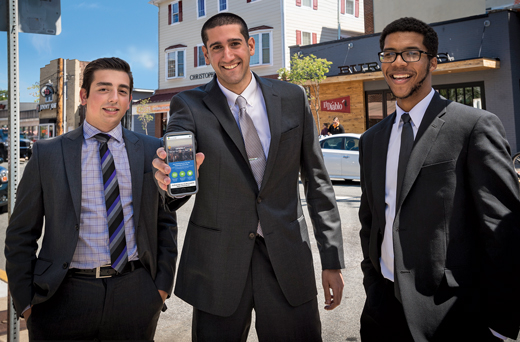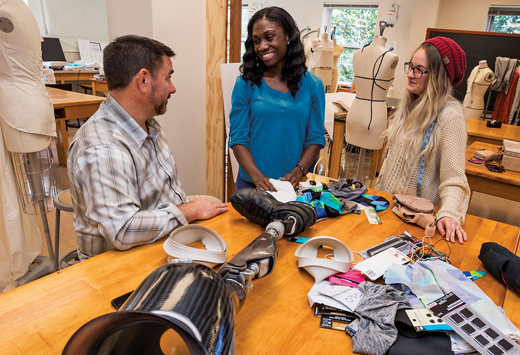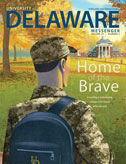Dive into
UD's 'Shark Tank'
Each spring, the newest generation of UD-nurtured entrepreneurs step onstage before a savvy and somewhat intimidating audience, take a deep breath and dive straight into seven of the longest minutes of their lives.
The event is called Hen Hatch, and the annual innovators’ “pitch competition” sponsored by Horn Entrepreneurship can be a crucial chance for these visionaries to gain the funding and legitimacy needed to bring their inventions to market.
In 2017, this “Shark Tank”-style competition offered $100,000 in prize money, split among the top-three finishers in two categories: students, and alumni-faculty-staff. Soon, these men and women may become familiar success stories. Here’s your chance to meet the first-place winners in each category and say you “knew them when.”

Virtual success
OUR STUDENTS | Jason Bamford has a vision. He imagines us living an existence where the digital conveniences we adore could magically appear before us, like a virtual reality game set in an endless mall.
In this world, we could get what we want, learn what we need to know—no cell phone needed. The richness of digital consumerism, already as close as our mobile devices and computers, would become visually integrated with our world view, seen through our eyes as we work and play.
He still thinks about that vision. But for now, Bamford, EG17, has quite enough to keep him occupied, thank you—things like being the star at press conferences with important state officials. Or lecturing the professors who once taught him, then catching a meeting with some venture capitalists. And, pushing ahead, bit by bit, investor by investor, the smartphone app he and his UD buddies Jordan Gonzalez, BE17, and Keith Doggett, EG17, have invented.
All while trying to finish up their degrees.
Their brainchild is called Geoswap, and in some ways, it resembles that virtual world Bamford imagined. At first, it was hard for people to understand the concept—until Pokémon Go came along.
Like the game that created adorable digital creatures for users to catch as they wandered the office or the street, Geoswap allows users to discover and “capture” digital knowledge—the location of a park trail, for example, or a discount at a pizza shop—as they travel in and about their world.
Looking at their real-time location on Geoswap’s GPS-linked map, users can see that a concert is about to get underway at that bar around the corner, and, as they walk through the door, get an alert from the business that there’s also a sweet deal on nachos tonight. At the table, they can use the app to check the menu, post pictures of their meal and plot their next adventure.
At the same time, businesses that participate are able to acquire crucial data on its Geoswap-driven business, allowing them to fine-tune their marketing efforts and engage customers in real time.
It’s an idea with plenty of excitement. Already, Geoswap has won thousands of dollars in startup funding through entrepreneurship competitions, placing third in the nation’s top undergraduate showdown. Earlier this year, the company signed a two-year, $19,000 partnership with the Delaware Tourism Office and state park system to promote destinations and events that would appeal to visitors.
Bamford and his partners sealed the deal in part by impressing initially skeptical state officials with their poise and professionalism. “The rollout of the partnership had immediate benefit for GeoSwap,” said Linda Parkowski, Delaware Tourism director. “The positive media coverage of our press conference with Geoswap led to approximately 1,000 downloads of the app in just three days.”
It’s all quite thrilling to these 22-year-olds, and frankly a little bizarre, finding themselves being taken so seriously by an adult world they just entered. “Speaking in front of people who used to teach us, it gets weird,” Gonzalez acknowledges.
At the same time, much of their product development efforts—sales calls, demonstrations, competitions, meetings—have to be shoehorned into their regular class schedules.
“We’ve pretty much been doing 40 hours a week each” on the Geoswap project, Doggett says.
“Subtract class and schoolwork, and the rest of our waking hours are Geoswap,” Gonzalez adds.
“There have been a bunch of 12-hour days,” Bamford says.
There will doubtlessly be more ahead, though unlike most UD graduates, they won’t have to spend time searching for a job.
“We’re all already hired, by Geoswap,” Bamford jokes.
“Great employers,” Gonzalez adds.

Force for good
Amira Idris could have done what was expected of her. She could have grabbed her degree, taken a great job doing good things and lived happily ever after.
Problem is, that’s not really the way Idris, EG15, BE16M, is put together.
In this 24-year-old’s mind, settling for ordinary outcomes would be extraordinarily uninspired. She’d rather choose the unexpected path and walk along that edge, to that place where the drop is steep, but the view looks so very grand.
The promise of the future is already here for this long-jumping, brainstorming, mile-a-minute biomedical engineer and graduate of UD’s master of science program in entrepreneurship and design. Even before she earned her undergraduate degree, Idris—who had already set a UD track and field record—was also pursuing an idea she had for a device that would alleviate the so-called “phantom pain” that surges from the area of amputees’ lost limbs.
“It can be excruciating,” she says. “For some people, they really can’t function.”
Over the next three years, Idris and her idea would win a succession of entrepreneur startup competitions, earn thousands of dollars in crucial capital and finally coalesce into a company called TheraV, where Idris and her team are now working toward producing a commercial device—just a year after getting her master’s.
None of it might have happened so fast without UD’s Horn Entrepreneurship and its annual Summer Founders Program, a 12-week "accelerator" that provides stipends, mentorship and weekly meetings with an adviser to students looking to develop their ventures.
“By the end of Summer Founders, basically I had a company,” Idris says.
At Horn, she and other budding entrepreneurs gained the encouragement, insights and guidance that so often turn ideas into reality. “It’s really given me the confidence to make the big leap,” she says. “Even your parents, when you graduate, they say, ‘Get a job.’ That’s the expected course.”
That thought was constantly in the back of her mind as she pushed her way forward. In time, through Horn, she would come to believe the words of the many experienced entrepreneurs she met: High aspirations do demand courage and will necessarily be accompanied by disappointments, but are within the grasp of those who believe.
“They tell me their failures and successes. They’ve gone through this. They say, ‘Amira, this is what you need to know.’”
In other things, she needs no teaching. Childhood days in Virginia were filled with tinkering and thinking. Taking things apart—trying to make this better. “My parents knew I could be doing something like this,” says Idris, who came to the U.S. from Nigeria with her family at age 9. “They were like, ‘Who took this apart? Amira!’
When it came time to put things together as a biomedical engineering student, Idris seized on a moment from her junior-year internship at a prosthetics clinic. A patient there was asked why he wasn’t taking better care of his leg.
“Why does it matter?” the man grumbled. “In a few years I’m going to die anyway.”
His hopelessness shocked Idris and prompted her to find out more about how pain could strike limbs that don’t even exist anymore. Poorly understood, and possibly related to crossed signals in the nervous system, phantom pains affect 80 percent of amputees, or 2 million people in the U.S.
For them, it’s a life of missed sleep, impaired function and reliance on expensive medications—which can cost $8,000 per year per person. Idris wondered if massaging the tissue at the amputation site would help increase circulation and muscle activity. She imagined a sleeve of sorts, worn over the amputation site and equipped with “vibromassage” nodes.
It was cheaper than drugs or physical therapy, had no side effects, and it seemed to work. Volunteers are now helping her test the device, which is estimated to retail at around $400. It all aligns neatly with her ambition to use her entrepreneurial ambitions for helping others.
“I’m very passionate about helping people however I can,” she says. “This drive has been part of me for as long as I remember.”




